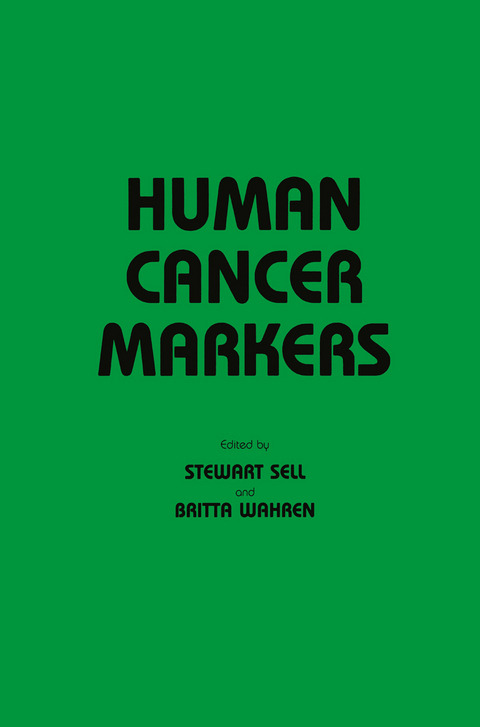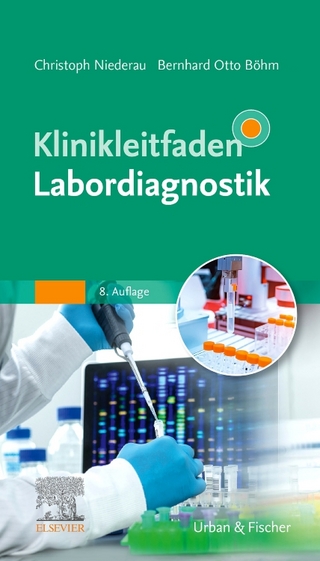
Human Cancer Markers
Humana Press Inc. (Verlag)
978-0-89603-029-9 (ISBN)
The ability to diagnose cancer by simple measurement of a serum or tissue' 'marker" has been a goal of medical science for many years. There is ample evidence that tumor cells are different from normal cells and pro duce substances that can be detected by currently available immuno chemical or biochemical methods. These "cancer markers" may be se creted proteins, enzymes, hormones, fetal serum components, monoclonal immunoglobulins, cell surface components, or cytoplasmic constituents. The purpose of this book is to present the current status of our knowledge of such cancer markers. The first tumor marker identified by laboratory means was Bence Jones protein. In a series of lectures delivered to the Royal College of Phy sicians in London in 1846, Dr. H. Bence Jones described studies on a urine sample sent to him with the following note: "Dear Dr. Jones-The tube contains urine of very high specific gravity. When boiled it becomes slightly opaque . . . . etc. " Dr. Jones found that heating of the urine after addition of nitric acid resulted in formation of a heavy precipitate; acid ad dition may have been required to bring the urine to pH 4-6 at which Bence Jones proteins are more likely to precipitate when heated. This urinary pre cipitate was associated with a bone disease termed "mollities ossium. " [H. Bence Jones, Papers on Chemical Pathology, Lecture III. Lancet 2, 269-274 (1847)].
1 Monoclonal Antibodies to Human Tumor Antigens.- 1. Introduction.- 2. Monoclonal Antibodies to Preselected Antigens—Technology.- 3. Monoclonal Antibodies to Human Tumors.- 4. Potential Diagnostic and Therapeutic Uses of Monoclonal Antibodies.- 5. Potential Problems with Monoclonal Antibody Usage.- 6. Final Comments.- References.- 2 Cell Surface Antigens on Normal and Neoplastic Human Lymphoid Cells.- 1. Three Major Classes of Immunocompetent Lymphocytes.- 2. Cell Surface Markers Defined by Monoclonal Antibodies.- 3. Clinical Applications.- 4. Summary.- References.- 3 An Immunochemical Approach to the Isolation of Human Melanoma-Associated Antigens.- 1. Introduction.- 2. Methods.- 3. Identification of MAA in Spent Culture Medium.- 4. Characterization of Melanoma-Associated Antigens.- 5. Preparation of Specific Antimelanoma Xenoantisera to 240K and 94K Antigens.- 6. Purification of 240K and 94K MAA from Spent Culture Medium.- 7. Summary.- References.- 4 Skin Tumor Markers.- 1. Introduction.- 2. Melanoma.- 3. Basal- and Squamous-Cell Carcinoma.- 4. Conclusion.- References.- 5 Gastrointestinal Cancer Markers.- 1. Introduction.- 2. Enzymes and Hormones in Gastrointestinal Tumor Disease.- 3. Tissue Antigens of Human Gastrointestinal Cancers Defined by Xenogeneic Antisera.- 4. Tissue Antigens of Human Large Bowel Cancers Immunogenic in the Host of Origin.- 5. Tissue Antigens of Rat Bowel Cancers.- 6 Hepatocellular Carcinoma Markers.- 1. Introduction.- 2. Liver Function Tests.- 3. Alphafetoprotein.- 4. Enzymes and Isoenzymes.- 5. Systematic Manifestations of Hepatoma and Ectopic Hormone Production.- 6. Ferritin.- 7. Hepatoma-Associated Antigens.- 8. Hepatitis B Virus.- 9. Summary.- References.- 7 Pancreatic Tumor Markers.- 1. Introduction.- 2. Pancreatic Oncofetal Antigen.-3. Comparison with Carcinoembryonic Antigen.- References.- 8 Prostote Cancer Markers.- 1. Introduction.- 2. Prostatic Acid Phosphatase.- 3. Prostate Antigen.- 4. Alkaline Phosphatase.- 5. Ribonuclease.- 6. Polyamines.- 7. Conclusions.- References.- 9 Breast Cancer Markers.- 1. Introduction.- 2. Structure of the Breast.- 3. Diseases of the Breast.- 4. Oncodevelopmental Markers.- 5. Differentiation Markers.- 6. Other Tumor-Associated Molecules.- 7. Candidate Tumor-Specific Markers.- 8. Immune Response Markers.- 9. Genetic Markers.- 10. Comment.- References.- 10 Ovarian and Uterine Cancer Markers.- 1. Oncodevelopmental Antigens.- 2. Enzymes.- 3. Other Antigens.- 4. Summary.- References.- 11 Testicular Cancer Markers.- 1. Introduction.- 2. Clinical Aspects of Testicular Cancer.- 3. Incidence and Specificity of AFP and HCG.- 4. Markers as Aids in Diagnosis and Staging.- 5. Markers in Monitoring and Followup.- 6. Markers in Seminoma.- 7. Other Uses of AFP and HCG in Testicular Cancer.- 8. Other Markers for Testicular Cancer.- 9. Location of Tumors with Oncodevelopmental Markers.- 10. Tumor Markers in Pathology.- 11. The Future.- References.- 12 Placental Proteins as Tumor Markers.- 1. Introduction.- 2. Placental Alkaline Phosphatase.- 3. Histaminase (Diamine Oxidase).- 4. Human Chorionic Gonadotropin.- 5. Pregnancy Specific Glycoprotein (SP1).- 6. Placental Proteins (PP1).- 7. Final Remarks.- References.- 13 Bladder and Renal Tumor Markers.- 1. Introduction.- 2. Bladder Cancer.- 3. Renal Cancer.- References.- 14 Endocrine Markers of Cancer: The Biological and Clinical Implications of Polypeptide Hormones.- Geoffrey Mendelsohn, Stephen B. Baylin.- 1. Introduction.- 2. Patterns of Inappropriate (Ectopic) Hormone Production by Tumors.- 3. Proposed Mechanisms of Inappropriate Hormone Production by Non-Endocrine Tumors.- 4. Markers in Endocrine Tumors.- 5. Markers in Non-Endocrine Tumors.- 6. Summary.- References.- 15 Lung Cancer Markers.- 1. Introduction.- 2. Oncofetal Proteins.- 3. Hormones.- 4. Serum Proteins.- 5. Enzymes.- 6. Other Substances.- Tennessee Antigen (TA).- References.- 16 Central Nervous System Tumor Markers.- 1. Introduction.- 2. Markers of Primary Intracranial Tumors.- 3. Markers of Metastatic Intracranial Tumors.- 4. Conclusion.- 5. Future Prospects.- References.
| Reihe/Serie | Contemporary Biomedicine ; 2 |
|---|---|
| Zusatzinfo | XX, 428 p. |
| Verlagsort | Totowa, NJ |
| Sprache | englisch |
| Maße | 155 x 235 mm |
| Themenwelt | Medizin / Pharmazie ► Medizinische Fachgebiete ► Onkologie |
| Studium ► 2. Studienabschnitt (Klinik) ► Anamnese / Körperliche Untersuchung | |
| Studium ► 2. Studienabschnitt (Klinik) ► Pathologie | |
| ISBN-10 | 0-89603-029-6 / 0896030296 |
| ISBN-13 | 978-0-89603-029-9 / 9780896030299 |
| Zustand | Neuware |
| Haben Sie eine Frage zum Produkt? |
aus dem Bereich


